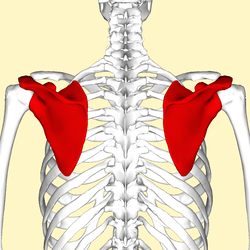Correct scapula positioning in relation to arm movement is essential in force generation and transfer with minimal joint loading. An imbalance in this can lead to greater shoulder and elbow loading and lead to lowered rotator cuff strength through muscle inhibition. This in turn can lead to impingement issues, instability and labral injuries.

Most scapula dysfunctions are commonly due to altered muscle activation. Normal scapula movement patterns involve upper and lower trapezius, rhomboids and serratus anterior. The lower trapezius and serratus anterior are the most susceptible to inhibition through incorrect muscle patterns as these are the muscles that are inhibited the most through the common “winging” scapula position.
Also tightness of the pec minor and short head of the biceps can effect scapula positioning as they both insert in the coracoid process, essentially causing a pulling motion through the blade.
Whilst these aliments most commonly effective “overhead” athletes such as baseball players and tennis players, correct global muscle activation is essential for correct and efficient biomechanics.
With that being said these are 4 big exercises where incorrect scapula positioning might be the issue holding you back from your big lift or causing you that niggling pain.
Bench
- With retracted scapulae, you are effectively shortening the distance the load must be moved.
- By keeping the scapulae in contact with the bench, you are creating an artificial stability – and thus a more stable based from which to generate force.
Row
- Correct Scapula movement patterns lead to lower force transmission onto the elbows and shoulder
- Less stress on the low back at the back extensors don’t need to isometrically contract to keep body upright and stable.
Deadlift
Non-protracted and stabilised scapula, common with “wing” caused by a weak or inactive serratus anterior and lower trapezes , will cause an excessive force on the front portion off the shoulder, stressing the joint and an in turn an over activation of the upper trapezes
This can lead to shoulder pain and inefficient lifting
Squat
Correct scapula stabilizing helps with technique as it enables you to bend forward whilst maintaining a strong neutral back, keeping your back from bowing
Incorrect scapula setting can lead to acromion depression, increasing the chance of impingement injuries or soreness at the shoulder
Being able to effectively “set” along with the abdominals leads to greater inter abdominal and thoracic pressure, which in turns leads to greater force transfer


